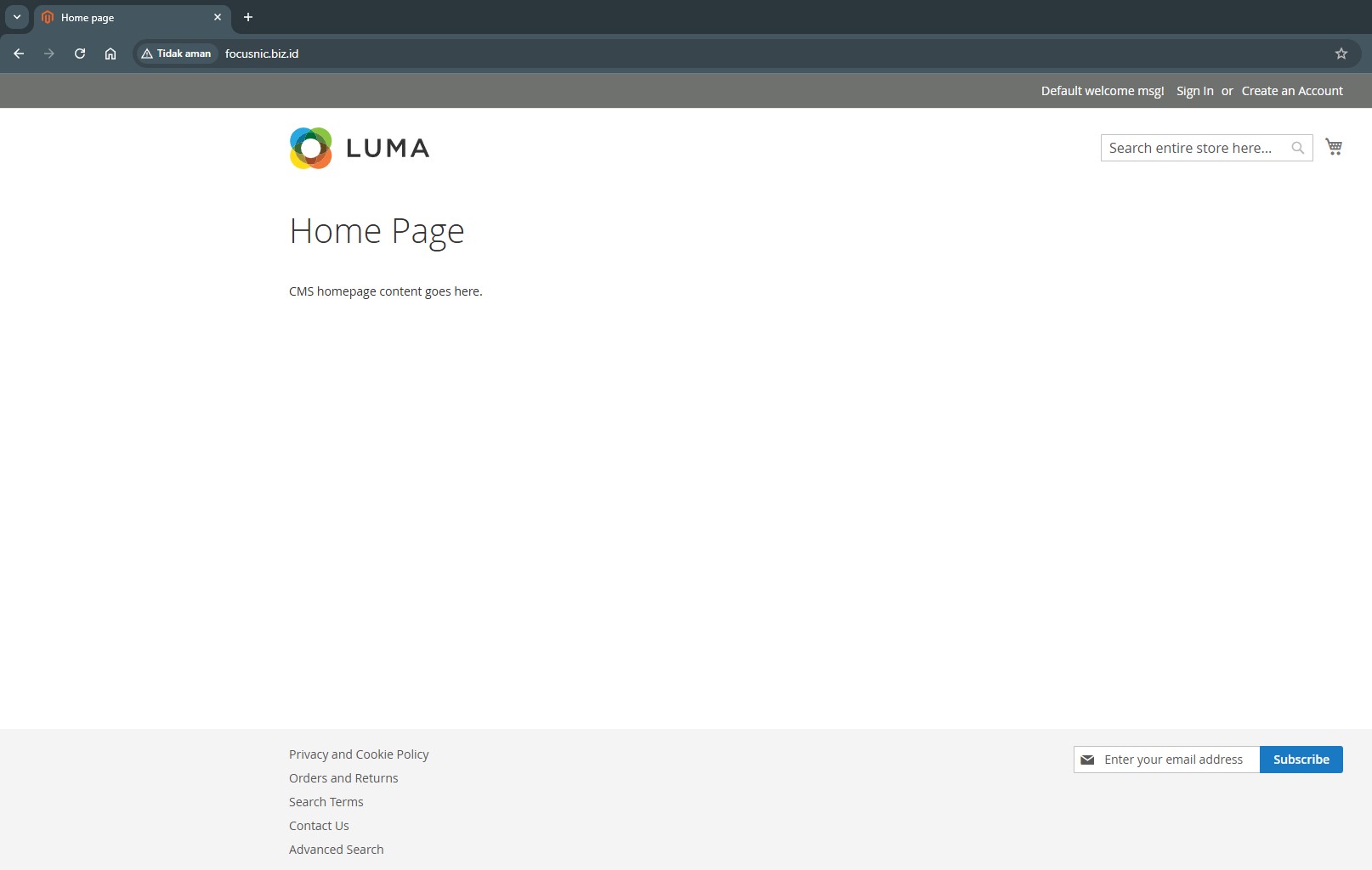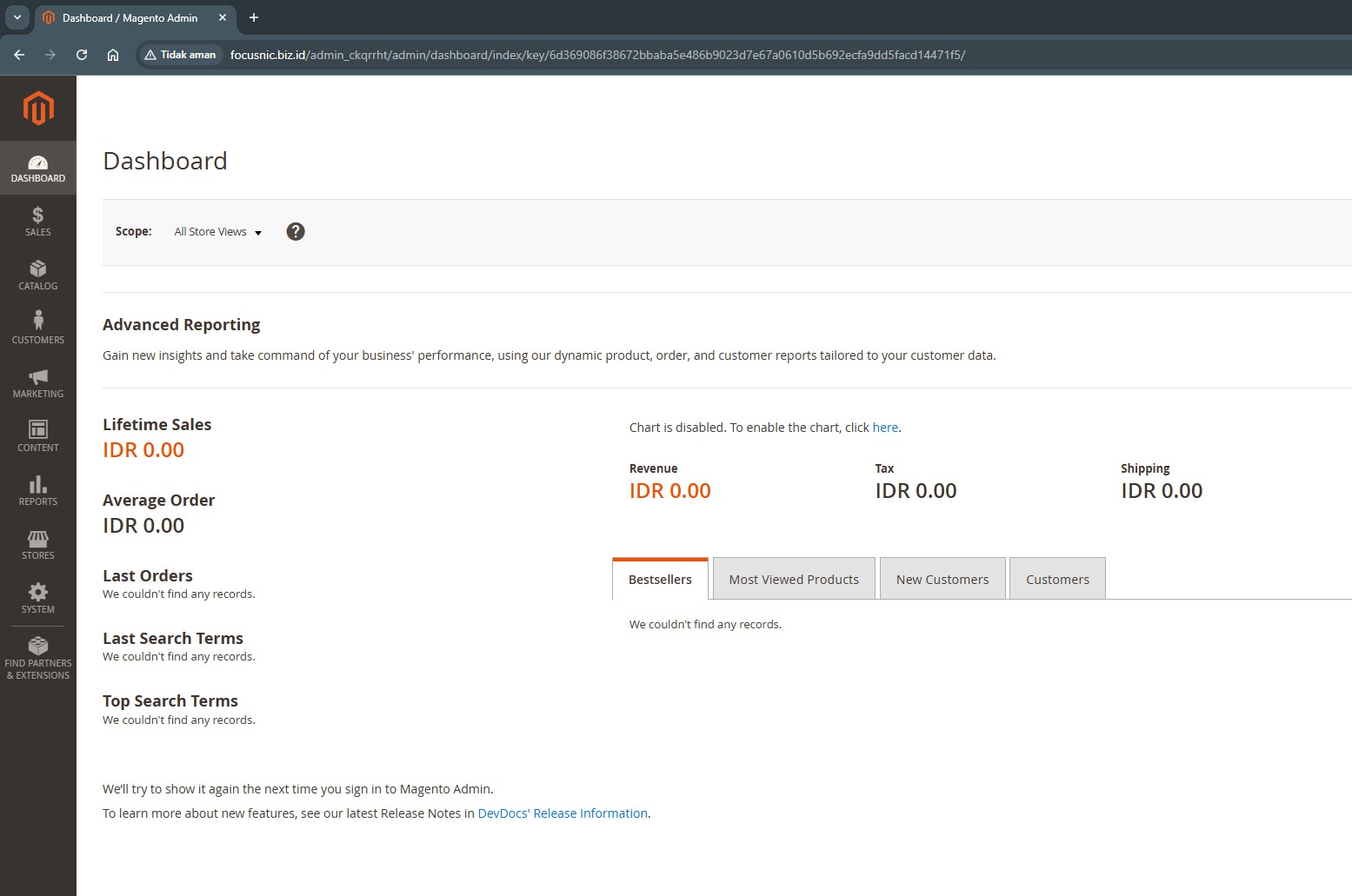Complete Guide on How to Install Magento Using LAMP Stack on AlmaLinux 8
Magento is one of the world's most popular and powerful open source e-commerce platforms, suitable for small to large-scale online stores. In this guide, we will cover in depth how to install Magento with a LAMP Stack (Linux, Apache, MySQL, PHP) on AlmaLinux 8, a stable RHEL distribution ideal for production servers.
Prerequisites
- Full root access
- Domain (optional)
- Basic Linux Command Line
Preparation
Make sure the firewall and SELinux have been adjusted or temporarily disabled if you want to avoid problems during the initial installation.
Before starting the installation process, ensure that your AlmaLinux 8 server is updated to the latest version. Use the following command to ensure the system is using the latest packages:
dnf update -y
dnf install epel-release -y
Install Apache
Apache is a reliable web server and is widely used in production environments. To install it, run the following command:
dnf install httpd -y
Once the installation is complete, enable and start the Apache service with the following command:
systemctl enable --now httpd
To allow access to the server via HTTP and HTTPS, allow the firewall:
firewall-cmd --permanent --add-service={http,https}
firewall-cmd --reload
Install PHP
PHP (Hypertext Preprocessor) is a server-side programming language that is crucial in this stack. We will install PHP 8 from the Remi Repository to use the latest version of PHP.
Run the following command to install the Remi Repository:
dnf install -y https://rpms.remirepo.net/enterprise/remi-release-8.rpm
Then list the available PHP using the following command:
dnf module list php
Output example:
AlmaLinux 8 - AppStream
Name Stream Profiles Summary
php 7.2 [d] common [d], devel, minimal PHP scripting language
php 7.3 common [d], devel, minimal PHP scripting language
php 7.4 common [d], devel, minimal PHP scripting language
php 8.0 common [d], devel, minimal PHP scripting language
php 8.2 common [d], devel, minimal PHP scripting language
Remi's Modular repository for Enterprise Linux 8 - x86_64
Name Stream Profiles Summary
php remi-7.2 common [d], devel, minimal PHP scripting language
php remi-7.3 common [d], devel, minimal PHP scripting language
php remi-7.4 common [d], devel, minimal PHP scripting language
php remi-8.0 common [d], devel, minimal PHP scripting language
php remi-8.1 common [d], devel, minimal PHP scripting language
php remi-8.2 common [d], devel, minimal PHP scripting language
php remi-8.3 common [d], devel, minimal PHP scripting language
php remi-8.4 common [d], devel, minimal PHP scripting language
Hint: [d]efault, [e]nabled, [x]disabled, [i]nstalled
Enable the desired PHP module version. For example, for PHP 8.4, run the following command:
dnf module reset php -y
dnf module enable php:remi-8.4 -y
Once the repository is active, we can proceed with installing PHP along with the commonly used essential modules:
dnf install -y php php-cli php-common php-mysqlnd php-fpm php-opcache php-gd php-curl php-mbstring php-xml php-json php-soap php-bcmath
Check the installed PHP version with the following command:
php -v
Install MariaDB
MariaDB is a replacement for MySQL and is compatible with MySQL-based applications. Run the following command to install it:
dnf module list mariadb
Output example:
AlmaLinux 8 - AppStream
Name Stream Profiles Summary
mariadb 10.3 [d] client, galera, server [d] MariaDB Module
mariadb 10.5 client, galera, server [d] MariaDB Module
mariadb 10.11 client, galera, server [d] MariaDB Module
Hint: [d]efault, [e]nabled, [x]disabled, [i]nstalled
The output above shows that the default version of MariaDB is 10.11 (the latest version from the OS). However, we'll use MariaDB version 11.4.7 using the official repository at https://mariadb.org/download/ and then reset MariaDB to remove it from the OS's default repository:
dnf module reset mariadb
Run the following command to add the MariaDB version 11.4.7 repository:
nano /etc/yum.repos.d/MariaDB.repo
Add the following parameters:
# MariaDB 11.4 RedHatEnterpriseLinux repository list - created 2025-07-31 14:04 UTC
# https://mariadb.org/download/
[mariadb]
name = MariaDB
# rpm.mariadb.org is a dynamic mirror if your preferred mirror goes offline. See https://mariadb.org/mirrorbits/ for details.
# baseurl = https://rpm.mariadb.org/11.4/rhel/$releasever/$basearch
baseurl = https://mirror.its.dal.ca/mariadb/yum/11.4/rhel/$releasever/$basearch
module_hotfixes = 1
# gpgkey = https://rpm.mariadb.org/RPM-GPG-KEY-MariaDB
gpgkey = https://mirror.its.dal.ca/mariadb/yum/RPM-GPG-KEY-MariaDB
gpgcheck = 1
Then run the following command to install MariaDB:
dnf install MariaDB-server MariaDB-client
Enable and activate the MariaDB service:
systemctl enable --now mariadb
systemctl status mariadb
Before using it for production or testing, it is best to secure the MariaDB installation first by running the following command:
mariadb-secure-installation
Then follow the instructions that appear:
- Enter current password for root (enter for none) → [ENTER]
- Switch to unix_socket authentication → Y
- Change the root password? → Y
- Remove anonymous users? → Y
- Disallow root login remotely? Y
- Remove test database and access to it? Y
- Reload privilege tables now? Y
Install Elasticsearch
Magento 2.4+ uses OpenSearch or Elasticsearch as the default search engine. However, before installing Elasticsearch, we'll install OpenJDK 11 (Java):
dnf install java-11-openjdk -y
Verify Java installation
java -version
Output example
openjdk version "11.0.25" 2024-10-15 LTS
OpenJDK Runtime Environment (Red_Hat-11.0.25.0.9-1) (build 11.0.25+9-LTS)
OpenJDK 64-Bit Server VM (Red_Hat-11.0.25.0.9-1) (build 11.0.25+9-LTS, mixed mode, sharing)
Add the Elasticsearch repository version 7.17.x to be compatible with Magento version 2.4.x. Run the following command:
rpm --import https://artifacts.elastic.co/GPG-KEY-elasticsearch
cat <<EOF | sudo tee /etc/yum.repos.d/elasticsearch.repo
[elasticsearch-7.x]
name=Elasticsearch repository for 7.x packages
baseurl=https://artifacts.elastic.co/packages/7.x/yum
gpgcheck=1
gpgkey=https://artifacts.elastic.co/GPG-KEY-elasticsearch
enabled=1
autorefresh=1
type=rpm-md
EOF
Then install Elasticsearch with the following command:
dnf install elasticsearch -y
Enable service Elasticsearch:
systemctl enable --now elasticsearch
Then test the Elasticsearch connection with the following command:
curl -X GET http://localhost:9200
Output example:
{
"name" : "localhost.localdomain",
"cluster_name" : "elasticsearch",
"cluster_uuid" : "72CpnzboRvOQqcoN1Oyq7g",
"version" : {
"number" : "7.17.29",
"build_flavor" : "default",
"build_type" : "rpm",
"build_hash" : "580aff1a0064ce4c93293aaab6fcc55e22c10d1c",
"build_date" : "2025-06-19T01:37:57.847711500Z",
"build_snapshot" : false,
"lucene_version" : "8.11.3",
"minimum_wire_compatibility_version" : "6.8.0",
"minimum_index_compatibility_version" : "6.0.0-beta1"
},
"tagline" : "You Know, for Search"
}
Install Magento
Before installing Magento, we'll first create a virtual host and database. Run the following command to create a virtual host:
Make sure you use a valid domain (FQDN) and also that the DNS A record is directed or pointed according to the server IP used on the server.
nano /etc/httpd/conf.d/focusnic.biz.id.conf
Fill in the following parameters:
<VirtualHost *:80>
ServerAdmin webmaster@focusnic.biz.id
ServerName focusnic.biz.id
ServerAlias www.focusnic.biz.id
DocumentRoot /var/www/focusnic.biz.id/public_html
<Directory /var/www/focusnic.biz.id/public_html>
AllowOverride All
Require all granted
</Directory>
ErrorLog /var/log/httpd/focusnic.biz.id-error.log
CustomLog /var/log/httpd/focusnic.biz.id-access.log combined
</VirtualHost>
Then create a directory on the virtualhost above:
mkdir -p /var/www/focusnic.biz.id/public_html
Restart Apache to save changes:
apachectl configtest
systemctl restart httpd
Create a database by running the following command:
mariadb
Then run the following command to create a database, user, and password:
create database magento_db;
create user 'magento_user'@'localhost' identified by 'pBpEWfEVOOdk9GP9';
grant all on magento_db.* to 'magento_user'@'localhost';
flush privileges;
quit;
Download composer and install it with the following command:
curl -sS https://getcomposer.org/installer | php
mv composer.phar /usr/local/bin/composer
Check composer version:
composer --version
Output example:
Composer version 2.8.10 2025-07-10 19:08:33
PHP version 8.4.10 (/usr/bin/php)
Download the Magento file and place it in the appropriate directory on the virtual host:
cd /var/www/focusnic.biz.id/public_html
wget https://github.com/magento/magento2/archive/refs/tags/2.4.8-p1.zip
unzip 2.4.8-p1.zip
mv magento2-2.4.8-p1/* .
Install packages or dependencies required by Magento using Composer:
cd /var/www/focusnic.biz.id/public_html
composer update
composer install
Adjust permissions:
cd /var/www/focusnic.biz.id/public_html
find var generated vendor pub/static pub/media app/etc -type f -exec chmod g+w {} +
find var generated vendor pub/static pub/media app/etc -type d -exec chmod g+ws {} +
chmod u+x bin/magento
chown -R apache:apache /var/www/focusnic.biz.id
Then install Magento using the following command and adjust the following parameters including domain, user, and password:
cd /var/www/focusnic.biz.id/public_html
bin/magento setup:install \
--base-url=http://"focusnic.biz.id" \
--db-host=localhost \
--db-name="magento_db" \
--db-user="magento_user" \
--db-password="pBpEWfEVOOdk9GP9" \
--admin-firstname="Admin" \
--admin-lastname="Focusnic" \
--admin-email="admin@focusnic.biz.id" \
--admin-user="admin" \
--admin-password="Admin123!" \
--language=id_ID \
--currency=IDR \
--timezone="Asia/Jakarta" \
--use-rewrites=1 \
--cleanup-database
Output example:
[SUCCESS]: Magento installation complete.
[SUCCESS]: Magento Admin URI: /admin_ckqrrht
Nothing to import.
Access the Magento installation via a browser, for example: http://focusnic.biz.id
If Magento won't open, make sure the .htaccess file is present in public_html. If not, add the following rewrite:
RewriteEngine on
RewriteCond %{REQUEST_URI} !^/pub/
RewriteCond %{REQUEST_URI} !^/setup/
RewriteCond %{REQUEST_URI} !^/update/
RewriteCond %{REQUEST_URI} !^/dev/
RewriteRule .* /pub/$0 [L]
DirectoryIndex index.php

Here is the admin area page, enter the password that was created previously and also the Admin URI of each installation that is generated will be different.

Troubleshooting
-
500 Internal Server Error
Make sure the permissions and.htaccessconfiguration are correct. -
PHP Memory Limit
Increase the limit by editing/etc/php.iniand set memory_limit = 2G. -
Could not validate a connection to the Elasticsearch. No alive nodes found in your cluster
Cause: Elasticsearch is not running, is configured incorrectly, or the port is closed. Make sure Elasticsearch is installed. -
Error: .htaccess not working or URL still contains index.php
Make sure the directory in Apache allows overriding:
<Directory /var/www/focusnic.biz.id/public_html>
AllowOverride All
</Directory>
Re-download the .htaccess file from the Magento Github repo if it was deleted.
Conclusion
The Magento installation process described above is quite lengthy, but it's well worth the effort to build an online store with comprehensive features and the ability to expand in the future. By using the LAMP Stack on AlmaLinux 8, we get a stable, secure, and high-performance system combination to run Magento optimally.
Q: Can Magento run on shared hosting?
A: Not recommended. Magento requires high resources, so it's better to use a VPS or dedicated server.
Q: Can you use Nginx?
A: Yes. However, in this guide, we'll focus on Apache because of its higher compatibility for beginners.
Q: What are alternative databases to MariaDB?
A: You can use MySQL Community Edition, but MariaDB is already very compatible.
Q: Is Elasticsearch required for Magento 2.4?
A: Yes. Starting with Magento 2.4 and above, Elasticsearch (or OpenSearch) is a required component. Without it, the installation will fail.
Q: I've installed everything, but the Magento page is still blank. Why?
A: Try running the following command:
cd /var/www/focusnic.biz.id/public_html
bin/magento setup:upgrade
bin/magento setup:di:compile
bin/magento setup:static-content:deploy -f
bin/magento cache:clean
bin/magento cache:flush
Check file permissions:
cd /var/www/focusnic.biz.id/public_html
find var generated vendor pub/static pub/media app/etc -type f -exec chmod g+w {} +
find var generated vendor pub/static pub/media app/etc -type d -exec chmod g+ws {} +
chmod u+x bin/magento
chown -R apache:apache /var/www/focusnic.biz.id
Further References: